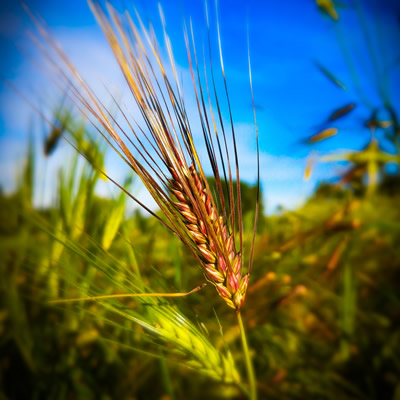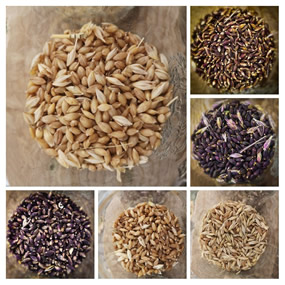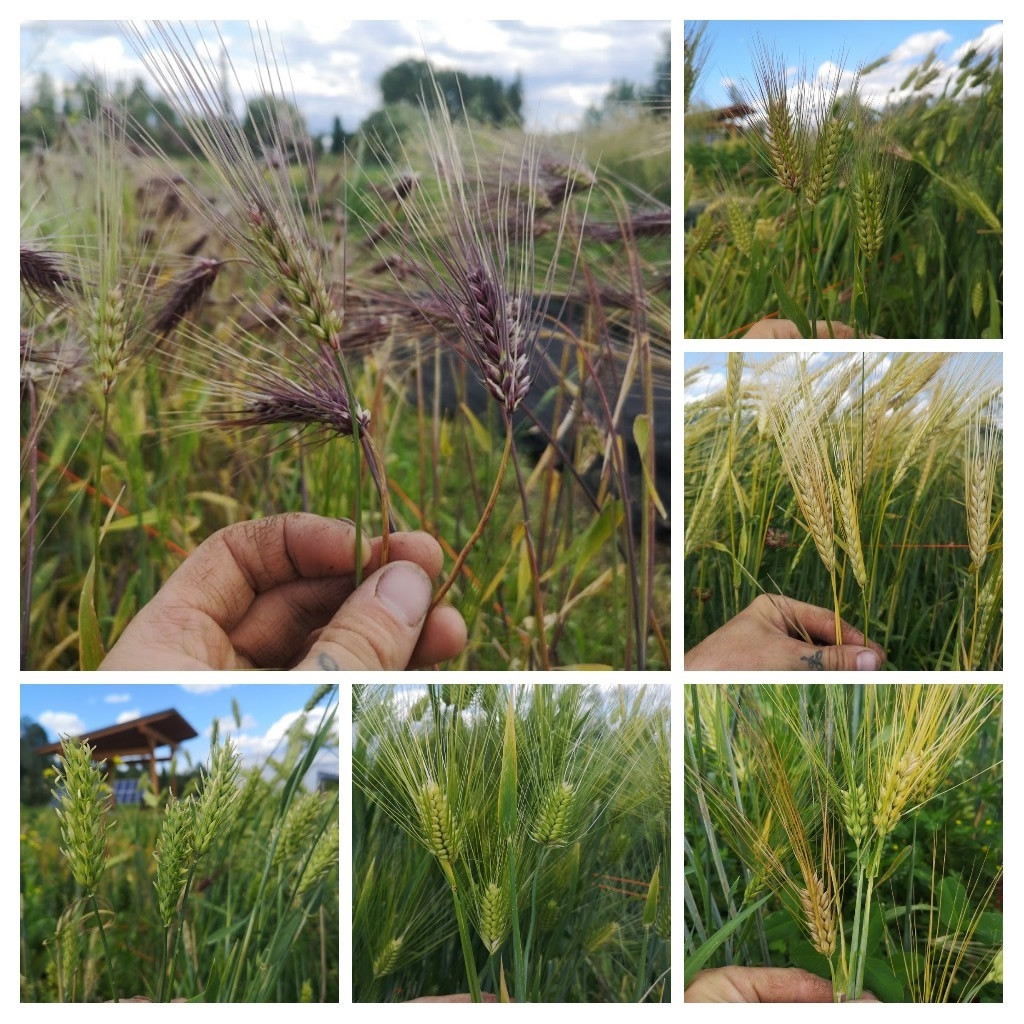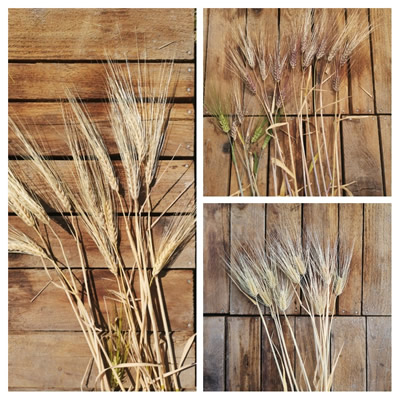GB Variety Trials
Biodiversity is an important consideration for long-term ecosystem sustainability, and the garden ecosystem is no exception! Growing a diverse selection of crops helps to create a balanced ecosystem, above and below the soil, but what about diversity of varieties of a given crop? Placing all our tomatoes in one basket can increase the risk of complete crop failure, especially in this age of climate change and climate extremes. By growing several varieties of a crop, we increase our chances of success, as some varieties will cope better with unexpected drought, or hundred-year storms, extreme cold, or insect and disease pressures. Another fantastic advantage to growing several varieties, is that we can observe which ones produce the highest yields, or mature the fastest, or grow the tallest! At the Kootenay Society for Sustainable Living our is goal to discover a minimum of 5 varieties of major crops, cereal grains, and root vegetables (to name a few) that are fast-maturing, high-yielding, and highly cold-tolerant for our mountain climate. Achieving this goal will provide us with some insurance against climate extremes AND help us to maximize the productivity of our mini-farm.
This year we are conducting a variety trial with barley, with a total of 15 different varieties! You may recognize some of them: Tibetan, Sumire Mochi, Streaker, Karan, Schrene, Gujar, Arabian Blue, Belford, Gopal, Faust, Ethiopian, Karma, Himalayan, Sangatsuga, and Bere. All but the last two are hulless varieties, and all were spring planted in mid-April. We started all the varieties the same way, broadcast into a mix of native soil and compost, and given the same amount of water every day. An important element to any variety trial is to eliminate as many variables as possible, so that the differences in growth, vigor and yield are a result of the genetic differences, and not caused by human intervention! We keep detailed records for each variety using Ecology Action's log sheet. Included in the log sheet are the variety name, source and year the seeds were produced, the quantity and date of seed broadcasting, the date of germination and transplanting as well as the spacing used and square feet of area planted, and notes on plant characteristics at time of transplant, such as root quantity and length, and seedling hardiness.
I should touch briefly on the additional benefits of conducting variety trials using open-pollinated seeds. Because we only use open-pollinated seeds, we have the benefit of being able to save our seed each year and replant the next, and the plants will grow true to type, or rather grow the same as the parent plants. The hidden benefit is that we can be selective in the seed saving task, selecting only from individuals that carried a specific trait we desire, such as resistance to extreme cold, like with the Tibetan Barley! We are also acclimatizing the variety to our specific growing conditions, sort of like helping the crop remember how things went this season, so it's better prepared for similar conditions next season. Doing this will increase yields year over year, as well as the crops ability to thrive in your climate.
We'll be conducting another Barley variety trial in 2020, with a twist: fall planting! Traditionally Barley is a spring planted grain, but we're keen to find out which varieties can survive our winters, giving us an additional edge in spring and potentially an earlier harvest! We've chosen our top 6 Barley's of 2019 to partake in this trial: Sangatsuga, Gopal, Faust, Sumire Mochi, Arabian Blue, and Karan. We based our decision on how well these 6 varieties coped with our extreme cold snap right after transplanting, their large number of tillers (and likely high yield) and for the speed in which they reached maturity. We'll plant additional varieties in spring to continue our efforts to discover the 5 best Barley's for our climate, a goal we hope to reach within the next 10 years. Our ultimate goal is to share our research, and seeds, with growers around the world who share similar growing environments, and to help people better feed themselves using less land and less resources. Be sure to check out the next edition of the Ecology Action Newsletter for an update on the final yield of all 15 varieties! top | Newsletter Home |Table of Contents| Archive
|



 So how do we begin? By conducting comprehensive variety trials, collecting data, and comparing the results to help us decide which crop varieties are optimal, and which are non-optimal for our specific growing environment. Following planting guides, planting zones, and weeks to maturity are a good place to start, but the only way to know for sure is to grow the crop yourself, and record as much data as is possible throughout the growing cycle.
So how do we begin? By conducting comprehensive variety trials, collecting data, and comparing the results to help us decide which crop varieties are optimal, and which are non-optimal for our specific growing environment. Following planting guides, planting zones, and weeks to maturity are a good place to start, but the only way to know for sure is to grow the crop yourself, and record as much data as is possible throughout the growing cycle.
 As the varieties grow, certain characteristics will stand out, such as tillering -the number of stalks an individual plant will grow for setting grain, the speed of growth, and the adaptability to our cold climate and alkaline soils. This year we experienced a cold snap just 2 days after finishing transplanting, with the overnight temperature dipping to -8.5 Celsius, or 17 degrees Fahrenheit! It was a blessing in disguise because it offered the opportunity to learn which varieties of Barley were most capable of dealing with such an extreme temperature when only very small and still recovering from transplanting. Some varieties saw losses of over 50%, some only 25%, and a few were completely unaffected! Arabian Blue, Sumire Mochi, and Himalayan were among the unscathed, Tibetan and Schrene the most damaged. Something to note though, variety trials like this are best repeated, at least 3 times, in order to assess whether or not there is a real trend in the observed differences. We'll regrow Tibetan again next year because it was our highest yielder the year prior, and even though we lost more than 50% of the plants to that extreme cold, we saved seed from the survivors, which will in turn provide us with seeds that have the genetic trait to resist extreme cold for the next variety trial!
As the varieties grow, certain characteristics will stand out, such as tillering -the number of stalks an individual plant will grow for setting grain, the speed of growth, and the adaptability to our cold climate and alkaline soils. This year we experienced a cold snap just 2 days after finishing transplanting, with the overnight temperature dipping to -8.5 Celsius, or 17 degrees Fahrenheit! It was a blessing in disguise because it offered the opportunity to learn which varieties of Barley were most capable of dealing with such an extreme temperature when only very small and still recovering from transplanting. Some varieties saw losses of over 50%, some only 25%, and a few were completely unaffected! Arabian Blue, Sumire Mochi, and Himalayan were among the unscathed, Tibetan and Schrene the most damaged. Something to note though, variety trials like this are best repeated, at least 3 times, in order to assess whether or not there is a real trend in the observed differences. We'll regrow Tibetan again next year because it was our highest yielder the year prior, and even though we lost more than 50% of the plants to that extreme cold, we saved seed from the survivors, which will in turn provide us with seeds that have the genetic trait to resist extreme cold for the next variety trial!
 We continue to collect data as the season progresses, recording when each variety sets grain, whether it is a 2, 4 or 6 row type, and as it reaches maturity, whether all the grain finishes uniformly, or at different times. We start to see significant differences in maturity as some varieties begin to turn golden yellow, and others remain green. Because we're selecting varieties that mature quickly due to our cold and short frosty growing season, (roughly mid-April to mid-September, with no frost-free growing months) we're always excited to find out who finishes the race first and gains the title of fastest! This season we had 4 varieties finish with that title: Sumire mochi, Tibetan, Himalayan and Ethiopian. All 15 varieties reached maturity with plenty of time to spare, and now hang in our drying area awaiting threshing and winnowing, and finally the weighing of the yield, both edible grain and straw biomass.
We continue to collect data as the season progresses, recording when each variety sets grain, whether it is a 2, 4 or 6 row type, and as it reaches maturity, whether all the grain finishes uniformly, or at different times. We start to see significant differences in maturity as some varieties begin to turn golden yellow, and others remain green. Because we're selecting varieties that mature quickly due to our cold and short frosty growing season, (roughly mid-April to mid-September, with no frost-free growing months) we're always excited to find out who finishes the race first and gains the title of fastest! This season we had 4 varieties finish with that title: Sumire mochi, Tibetan, Himalayan and Ethiopian. All 15 varieties reached maturity with plenty of time to spare, and now hang in our drying area awaiting threshing and winnowing, and finally the weighing of the yield, both edible grain and straw biomass.
